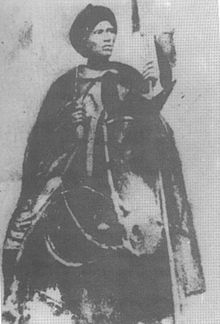History of Senegal
[1] The presence of man in the Lower Paleolithic is attested by the discovery of stone tools characteristic of Acheulean such as hand axes reported by Théodore Monod[2] at the tip of Fann in the peninsula of Cap-Vert in 1938, or cleavers found in the south-east.
Mousterian Industry is represented mainly by scrapers found in the peninsula of Cap-Vert, as well in the low and middle valleys of the Senegal and the Falémé.
Some pieces are explicitly linked to hunting, like those found in Tiémassass, near M'Bour, a controversial site that some claim belongs to the Upper Paleolithic,[4] while other argue in favor of the Neolithic.
Other approaches exist such as that of Guy Thilmans and his team in 1980,[11] who felt that any archeology from pre-colonial could be attached to that designation or that of Hamady Bocoum, who speaks of "Historical Archaeology" from the 4th century, at least for the former Tekrur.
Combining these data suggests that Senegal was first populated from the north and east in several waves of migration, the last being that of the Wolof, the Fulani and the Serer who dominate the area today.
Oral traditions relate that in much of northern Senegal Mande people were the earliest inhabitants, although archaeological evidence of this is slim.
[24] Africanist historian Donald R. Wright has suggested that place-names in the Gambia and Casamance regions indicate "that the earliest inhabitants might be identified most closely with one of several related groups—Bainunk, Kasanga, Beafada... To these were added Serer, who moved southward during the first millennium A.D. from the Senegal River valley, and Mande-speaking peoples, who arrived later still from the east.
"[25] He also cautions, however, that attempting to project modern-day ethnic definitions onto people who lived hundreds or thousands of years ago is at best highly speculative and at worst counterproductive.
The cores of these great empires were located on the territory of the current Republic of Mali, so current-day Senegal occupied a peripheral position.
[27] The earliest of these empires is that of Ghana, probably founded in the first millennium by Soninke and whose animist populations subsisted by agriculture and trade across the Sahara,[28] including gold, salt and cloth.
[29][30] John Donnelly Fage suggests that Takrur was formed through the interaction of Berbers from the Sahara and "Negro agricultural peoples" who were "essentially Serer" although its kings after 1000 CE might have been Soninke (northern Mande).
Historian Sylviane Diouf states that "Each vassal kingdom—Walo, Takrur, Kayor, Baol, Sine, Salum, Wuli, and Niani—recognized the hegemony of Jolof and paid tribute.
The decline of these kingdoms can be explained by internal rivalries, then by the arrival of Europeans, who organized the mass exodus of young Africans to the New World.
[47] Ghazis, wars, epidemics and famine afflicted the people, along with the Atlantic slave trade, in exchange for weapons and manufactured goods.
In Casamance, the Baïnounks, the Manjaques and Diola inhabited the coastal area while the mainland – unified 13th century under the name of Kaabu – was occupied by the Mandingo.
[48] According to several ancient sources, including occasions by the Dictionnaire de pédagogie et d'instruction primaire by Ferdinand Buisson in 1887,[49] the first French settlement in Senegal dates back to the Dieppe Mariners in the 14th century.
Flattering for Norman sailors, this argument gives credence also to the idea of a precedence of the French presence in the region, but it is not confirmed by subsequent work.
In the mid-15th century, several European nations reached the coast of West Africa, vested successively or simultaneously by the Portuguese, the Dutch, the English and French.
[51] In 1444 Dinis Dias went off the mouth of the Senegal River to reach the westernmost point of Africa he calls Cabo Verde, Cape Vert,[52] because of the lush vegetation seen there.
Grand Master of the naval war of Louis XIV, Admiral Jean II d'Estrées seized Gorée on 1 November 1677.
[62] Appointed governor in 1785, Knight Boufflers focuses for two years to enhance the colony, while engaged in the smuggling of gum arabic and gold with signares.
The Europeans were sometimes disappointed because they hoped to find more gold in West Africa, but when the development of plantations in the Americas, mainly in the Caribbean, in Brazil and in the south of the United States raised a great need for cheap labor, the area received more attention.
States and kingdoms competed, along with private traders who became much richer in the triangular trade (although some shipments resulted in real financial disaster).
After the departure of Governor Schmaltz (he had taken office at the end of the wreck of the Medusa), Roger Baron particularly encouraged the development of the peanut, "the earth pistachio", whose monoculture would be long because of the severe economic backwardness of Senegal.
Those few Africans from the four communes who were able to pursue higher education and were willing to renounce their legal protections could "rise" to be termed Évolué ("Evolved") and were nominally granted full French citizenship, including the vote.
On 27 April 1848, following the February revolution in France, a law was passed in Paris enabling the Four Communes to elect a Deputy to the French Parliament for the first time.
On 30 December 1875 this seat was again abolished, but only for a few years as it was reinstated on 8 April 1879, and remained the single parliamentary representation from sub-Saharan Africa anywhere in a European legislature until the fall of the third republic in 1940.
After the breakup of the Mali Federation, President Senghor and Prime Minister Mamadou Dia governed together under a parliamentary system.
In 1980, President Senghor retired from politics, and handed power over to his handpicked successor, Prime Minister Abdou Diouf, in 1981.
However, at the beginning of 2007, refugees began fleeing again as the sight of Senegalese troops rekindled fears of a new outbreak of violence between the separatists and the government.

















